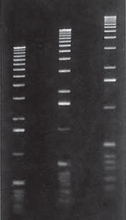 Loading... Please wait...
Loading... Please wait...Categories
Agarose
Agarose Low Electroendosmosis (Agarose LE)
Agarose LE is used in electrophoresis, chromatography, molecular biology and biochemistry techniques. The most common application of our Agarose LE is for the separations of nucleic acids. Agarose is a natural product that forms an inert matrix that is neutral and easily derivatizable, so it is easy to bind to its structure proteins like enzymes, antigens or antibodies. Being non-toxicity makes working with agarose easy and convenient. Agarose LE is designed for seperating oligonucleotides between 0.2 – 23kbp depending on the concentration used.
Applications:
• High electrophoresis mobility
• Nucleic acid analytical and preparative electrophoresis
• Blotting assays
• Protein electrophoresis such as radial immunodiffusion
Features:
• Extraordinary mechanical resistance for more reliable and easier handling
• Excellent transparency of the gel and high visibility
• Exceptionally low absorption of staining agents
• Absence of toxicity (polyacrylamide is neurotoxic)
• Possibility of varying pore size in accordance with particle size by modifying the gel concentration
• Easy preparation of the gel by simple dilution in aqueous buffers either by standard boiling or microwaving
• Greater thermal stability due to high hysteresis (difference between gelling and melting temperatures)
Technical Specifications:
CAS: 9012-36-6
EEO (Electroendosmosis) ≤ 0.12 Sulfate ≤ 0.1%
Gel Strength 1.5% Solution ≥ 1500 g/cm2 (Nikan)
Gelling temperature 36 ± 1.5 °C
Melting tempterature 88 ± 1.5 °C
DNAse and RNAse activity not detected
DNA resolution ≥ 1000 bp finely resolved
Gel Background and DNA Binding very low
Storage:
Store in a dry place at 15-25°C
Agarose Low Melting (Agarose LM)
Low melting (gelling temperature) agarose is suitable for DNA/RNA recovery from the gel, tissue culture and viral plaque assays.
Technical Specifications:
Gel Strength 1.5% Solution ≥ 500 g/cm2 (Nikan)
Gelling temperature between 24-28°C
Melting tempterature < 66.5°C
Agarose Fine Resolution (Agarose LX)
Agarose is designed for the separation of small fragments of DNA fragments less than 1000 bp for such applications as molecular screening.
Gel Strength 1.5% Solution ≥ 1500 g/cm2 (Nikan)
Gelling temperature between < 35.5°C
Melting tempterature < 80.0°C
All Agarose Pricing Include Free Shipping within the Continental USA
How to prepare and pour an Agarose LE gel:
GEL PREPARATION TIPS
1. Always use a beaker 2-4 times the volume of the solution.
2. Add agarose powder slowly into rapidly stirring buffer solution to avoid clumping.
3. The buffer solution should be cool for a good dispersion; if the buffer is warm, possibilities of clumping are great.
4. Allow agarose powder to hydrate in the solution for a few minutes before heating - this allows for a quicker and easier dissolution and reduces foaming.
5. Adjust time and power settings according to your microwave output strength.
6. Always wear appropriate protection: the microwaved solution can become overheated and foam when disturbed.
7. To prevent overheating: reduce microwave power, remove beaker after 1 min from the microwave and swirl it very gently and
carefully. Place it back into the microwave and continue for the remaining 1 minute or so.
8. For total agarose melting: boil the solution only enough to affect total dissolution. Check for “fish eyes” (incomplete dissolution).
Keep in minc that overboiling can cause agarose hydrolysis and lower gel strength.
9. To avoid bubble formation: cool to 60ºC and pour carefully into the gel cassette.
10.After pouring, allow the gel to cool gradually; rapid cooling will cause irregular gel matrix and band distortion during electrophoresis.
11.Low melt agarose gels need to sit for an additional 30 min or overnight at 4-8ºC to allow a total gelling process.
12.Low melting or low percentage gels: it is important to run electrophoresis in a cold buffer. High voltages can cause overheating of
the buffer which can melt the gel.
13.Buffer composition can be determinative in the gelling process, if agents that disrupt hydrogen bond formation are added to the
buffer, melting temperature and gel strength will decrease, or even inhibit gel formation.
14.Once the gel is set, flood with the buffer. The gel can be stored refrigerated for several days.
15.Agarose gels can be remelted and repoured several times without damage so that a large volume of agarose can be prepared and
smaller portions taken from time to time.
Celebrity Endorsements
Lorber, B., et. al. (1999) Crystallization within agarose gel in microgravity improves the quality of thaumatin crystals. Acta Crystallographica Section D: Biological Crystallography. Vol 55. 1491-1494.

